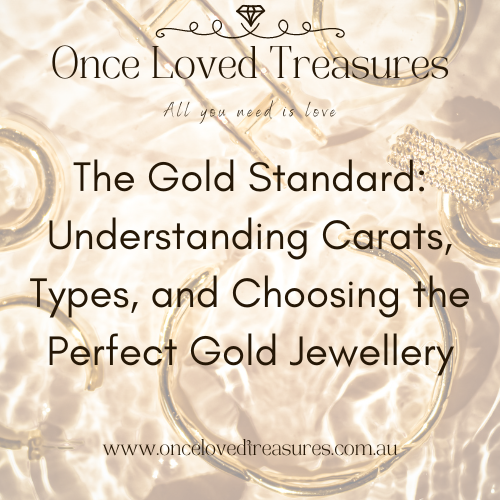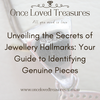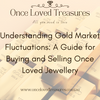
The Gold Standard: Understanding Carats, Types, and Choosing the Perfect Gold Jewellery
The Gold Standard: Understanding Carats, Types, and Choosing the Perfect Gold Jewellery
Welcome to Once Loved Treasures, where we celebrate the timeless beauty of fine jewellery. Gold, with its rich history and enduring appeal, is a popular choice for many jewellery enthusiasts. However, choosing the right gold for your jewellery can be a complex task, given the variety of carats, types, and colours available. In this comprehensive guide, we’ll explore the different carats and types of gold, what metals are used, how to identify them, and how to make educated choices when selecting gold for your jewellery. We'll also provide tips on finding the right carat for your preferred piece, and how to choose the best tone of gold for your skin complexion and personal style.
Understanding Gold Carats
What Are Carats?
Carats (or karats, in the U.S.) measure the purity of gold. Pure gold is 24 carats (24K), but pure gold is too soft for most jewellery, so it is alloyed with other metals to improve its durability. The carat number indicates how many parts of pure gold are present out of 24. For example, 18K gold is 18 parts gold and 6 parts other metals.
Common Gold Carats
-
24K Gold (Pure Gold):
- Composition: 99.9% gold.
- Characteristics: Bright yellow, very soft, and prone to scratching and bending.
- Usage: Rarely used for jewellery, more common in investment and ceremonial pieces.
-
22K Gold:
- Composition: 91.6% gold, alloyed with other metals like silver or copper.
- Characteristics: Still quite soft but more durable than 24K. Retains a rich yellow colour.
- Usage: Popular in Asian jewellery, particularly in countries like India.
-
18K Gold:
- Composition: 75% gold, 25% other metals (typically copper, silver, zinc).
- Characteristics: Durable, rich colour, and suitable for fine jewellery.
- Usage: Widely used in high-end and fine jewellery.
-
14K Gold:
- Composition: 58.5% gold, 41.5% other metals.
- Characteristics: Durable, more resistant to scratching and bending, with a balanced colour.
- Usage: Common in everyday jewellery.
-
10K Gold:
- Composition: 41.7% gold, 58.3% other metals.
- Characteristics: Very durable, less yellow than higher carat gold.
- Usage: Often used in affordable jewellery and pieces that require extra durability.
Types of Gold and Alloys
Yellow Gold
- Composition: Gold alloyed with copper and silver.
- Characteristics: Classic gold colour, warm and rich.
- Usage: Traditional choice for all types of jewellery.
White Gold
- Composition: Gold alloyed with white metals like palladium or nickel, often plated with rhodium for extra brightness.
- Characteristics: Silvery-white appearance, modern and elegant.
- Usage: Popular in engagement rings and modern jewellery designs.
Rose Gold
- Composition: Gold alloyed with a higher proportion of copper.
- Characteristics: Pinkish-red hue, romantic and vintage feel.
- Usage: Increasingly popular in contemporary and vintage-inspired jewellery.
Green Gold
- Composition: Gold alloyed with silver and sometimes a small amount of zinc.
- Characteristics: Subtle greenish tint.
- Usage: Rare and often used in combination with other gold colours for unique designs.
Identifying Genuine Gold
Hallmarks and Stamps
- Purity Marks: Look for stamps indicating the carat (e.g., 18K, 750).
- Assay Office Marks: Verify the origin of the hallmark to ensure authenticity.
- Maker’s Marks: Check for a maker’s mark to identify the jeweller or manufacturer.
Professional Appraisal
- Seek Certification: When in doubt, have the piece appraised by a certified jeweller or gemologist.
- Check for Consistency: Ensure all hallmarks and stamps are consistent with the claimed purity and type of gold.
Making Educated Choices When Choosing Gold Jewellery
Consider Your Lifestyle
-
Daily Wear vs. Special Occasions:
- For everyday wear, opt for 14K or 18K gold for better durability.
- For special occasions, 18K or 22K gold pieces offer a richer appearance but should be worn with care.
-
Activity Level:
- If you lead an active lifestyle, choose gold that can withstand wear and tear, such as 14K or 10K.
Matching Gold to Your Skin Tone
-
Warm Skin Tones:
- Yellow and rose gold complement warm undertones beautifully.
- Look for pieces that enhance the natural warmth of your skin.
-
Cool Skin Tones:
- White gold and platinum are ideal for cool undertones.
- These metals bring out the natural radiance of cool skin tones.
-
Neutral Skin Tones:
- Lucky you! You can wear all types of gold. Mix and match to suit your style and preference.
Fashion and Personal Style
-
Wardrobe Considerations:
- Match gold tones to the colours you frequently wear.
- Yellow gold pairs well with earthy and warm colours.
- White gold complements cooler shades and black.
- Rose gold adds a pop of colour and works well with neutrals and pastels.
-
Trends vs. Timeless Pieces:
- Invest in classic pieces that never go out of style.
- Experiment with trendy designs for fun, knowing that they might not always be in vogue.
Questions to Ask When Buying Gold Jewellery
-
What Is the Gold Purity?
- Confirm the carat and check for appropriate hallmarks.
- Confirm the carat and check for appropriate hallmarks.
-
What Metals Are Used in the Alloy?
- Be aware of any potential allergies, especially with white gold that may contain nickel.
- Be aware of any potential allergies, especially with white gold that may contain nickel.
-
Is the Gold Plated?
- Understand the difference between solid gold and gold-plated pieces. Gold plating can wear off over time.
- Understand the difference between solid gold and gold-plated pieces. Gold plating can wear off over time.
-
What Is the Return Policy?
- Ensure there is a clear return policy in case the piece does not meet your expectations.
- Ensure there is a clear return policy in case the piece does not meet your expectations.
-
Does the Piece Come with a Certificate?
- A certificate of authenticity can provide assurance of the gold’s purity and quality.
Tips for Finding the Right Gold Jewellery
Research Reputable Sellers
- Check Reviews and Ratings: Look for feedback from other customers to gauge the seller’s reputation.
- Verify Credentials: Ensure the seller is accredited by relevant jewellery organisations.
Inspect the Jewellery
- Examine the Hallmarks: Use a magnifying glass to inspect the stamps and hallmarks.
- Assess Craftsmanship: Look for signs of quality craftsmanship, such as secure settings and smooth finishes.
Make Use of Technology
- Online Tools: Use online databases and resources to verify hallmarks and maker’s marks.
- Virtual Try-Ons: Some jewellers offer virtual try-ons to help you see how a piece will look on you.
Budget Considerations
- Set a Budget: Determine your budget before shopping to narrow down your options.
- Compare Prices: Look at similar pieces from different sellers to ensure you’re getting a fair price.
Checklist for Buying Gold Jewellery
-
Verify Hallmarks:
- Check the purity, assay office, and maker’s marks.
-
Understand the Alloy:
- Know what metals are used and check for potential allergens.
-
Check Craftsmanship:
- Look for high-quality construction and secure settings.
-
Research the Seller:
- Ensure they have good reviews and proper credentials.
-
Ask for a Certificate:
- Get a certificate of authenticity for added assurance.
-
Know the Return Policy:
- Ensure you understand the return policy before purchasing.
Conclusion
Choosing the perfect gold jewellery involves understanding the different carats, types, and alloys, as well as making informed decisions based on your lifestyle, skin tone, and personal style. At Once Loved Treasures, we’re committed to helping you find pieces that not only enhance your collection but also bring joy and elegance to your life. By following these tips and guidelines, you can confidently select gold jewellery that will be cherished for years to come. Happy treasure hunting!

